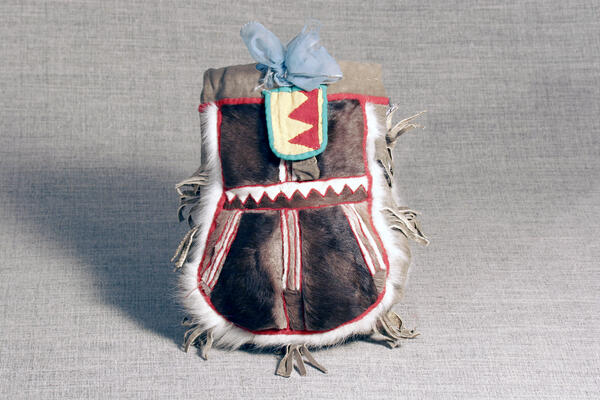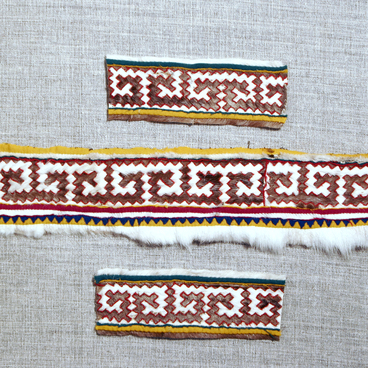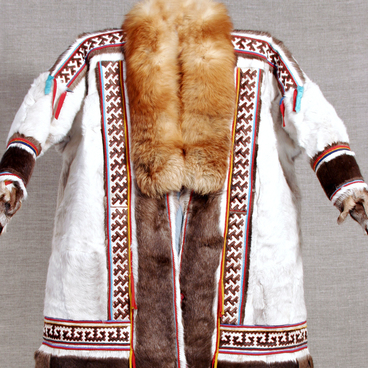A woman’s main responsibility during her whole life is sewing clothing and footwear. The art of handling a needle and a thread is learnt by every girl at an early age. At about four or five, girls try to sew on their own and immediately obtain a needlework bag, called a “tushAn” by the Forest NEnets.
The bag is rounded at the bottom and narrowed at the top. Its front part is made of reindeer forehead fur. To conjugate the parts, there’s a colored suede strip inserted on the sides. The suede is dyed with natural materials like a larch sap or a sandstone. The oval shape of a ‘tushan’ is outlined with a strip of fur ornament. The bag is decorated on the sides with metal buttons or bullet casings, which are a kind of amulets protecting from hostile forces and evil spirits.
A ‘tushan’ is believed to have a patron — nimi kata or niba kata. The Forest Nenets women inevitably connect the image of a needlework accessories keeper with a spider. It constantly spins the laces of its web just like a woman sews all her life to provide the whole family with clothes and keep them warm. There’s a belief that if you kill a spider, nimi kata will hide your sewing tools. Traditionally, the bag should never be empty. Usually there are pincushions and needles, thimbles, reindeer tendon threads tied to a special loop, pieces of cloth and fur for decoration stored inside.
Just like a man’s belt with a knife and tools attached to it, a traditional needlework bag is a symbol of a NEnets woman’s dignity. A “tushAn” is the first thing a bride takes with her to her new family. A faithful companion, a needlework bag follows a Nenets woman during her whole life. In a wedding caravan it lays next to the bride in the sledge; if a bride is stolen, this bag is the only thing she takes with her. If some close relative dies, the bag is turned with the face to the wall, it “mourns” together with the family.
The bag is rounded at the bottom and narrowed at the top. Its front part is made of reindeer forehead fur. To conjugate the parts, there’s a colored suede strip inserted on the sides. The suede is dyed with natural materials like a larch sap or a sandstone. The oval shape of a ‘tushan’ is outlined with a strip of fur ornament. The bag is decorated on the sides with metal buttons or bullet casings, which are a kind of amulets protecting from hostile forces and evil spirits.
A ‘tushan’ is believed to have a patron — nimi kata or niba kata. The Forest Nenets women inevitably connect the image of a needlework accessories keeper with a spider. It constantly spins the laces of its web just like a woman sews all her life to provide the whole family with clothes and keep them warm. There’s a belief that if you kill a spider, nimi kata will hide your sewing tools. Traditionally, the bag should never be empty. Usually there are pincushions and needles, thimbles, reindeer tendon threads tied to a special loop, pieces of cloth and fur for decoration stored inside.
Just like a man’s belt with a knife and tools attached to it, a traditional needlework bag is a symbol of a NEnets woman’s dignity. A “tushAn” is the first thing a bride takes with her to her new family. A faithful companion, a needlework bag follows a Nenets woman during her whole life. In a wedding caravan it lays next to the bride in the sledge; if a bride is stolen, this bag is the only thing she takes with her. If some close relative dies, the bag is turned with the face to the wall, it “mourns” together with the family.



